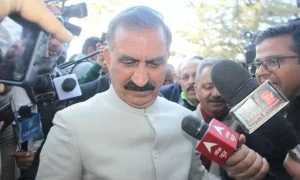Himachal Pradesh – A catastrophic Himachal landslide in Bilaspur district claimed 18 lives on Tuesday evening when massive boulders struck a private bus carrying passengers. The tragedy unfolded in the Balughat area of Jhanduta subdivision as heavy rainfall triggered the deadly landslide that completely crushed the bus beneath falling debris and stones, prompting immediate rescue operations by multiple agencies.
Details of the Himachal Landslide Tragedy

The Himachal landslide occurred at approximately 6:30 pm on Tuesday when a portion of the mountain collapsed onto the private bus traveling from Marottan to Ghumariwin. The bus was carrying between 28 to 30 passengers when the rain-triggered landslide sent massive boulders cascading down the hillside, directly striking the vehicle and trapping passengers beneath the debris.
Officials confirmed that 18 bodies have been recovered from the mangled remains of the bus following the Himachal landslide. The vehicle was completely crushed by the falling debris and stones that struck its roof, leaving rescue teams facing challenging conditions as they worked to extract victims from the wreckage throughout the night.
Rainfall Data and Weather Conditions
Bilaspur district recorded 12.7 millimeters of rainfall on October 7, creating conditions that destabilized the mountain slopes and triggered the deadly Himachal landslide. The heavy rain saturated the hillside soil, causing the massive section of mountain to give way and send boulders crashing onto the roadway below where the bus was traveling.
The Himachal landslide occurred in the Bhalu area near Barthi, a region known for its steep terrain and vulnerability to slope failures during monsoon and post-monsoon rainfall periods. The accident site’s geographic characteristics, combined with intense precipitation, created perfect conditions for the catastrophic hillside collapse.
Rescue Operations Following Himachal Landslide

Immediately following the Himachal landslide, local administration, police personnel, and State Disaster Response Force teams rushed to the accident site to conduct relief and rescue operations. The response effort continued late into the night as rescue workers worked to locate and extract passengers from beneath the massive debris pile created by the landslide.
JCB machines were pressed into service to carefully remove debris and stones covering the crushed bus following the Himachal landslide. Rescue teams faced significant challenges due to the unstable terrain, ongoing risk of additional rockfalls, and the extensive damage to the vehicle that made victim extraction extremely difficult and time-consuming.
Also Read: Cuttack Erupts in Violence: 36-Hour Curfew and 60 Platoons of Police Struggle to Contain Unrest
Survivors and Medical Treatment
Among those rescued from the Himachal landslide scene, three children survived the impact and were immediately transported to a hospital in Berthin for emergency medical treatment. The injured passengers received urgent medical attention as the district administration ensured adequate arrangements for their treatment and ongoing care needs.
Deputy Chief Minister Mukesh Agnihotri confirmed the death toll from the Himachal landslide, stating that 18 people total, including 15 confirmed fatalities, had been recovered from the accident site. However, authorities acknowledged uncertainty about the exact number of passengers aboard the bus, complicating efforts to determine whether all victims had been accounted for following the Himachal landslide.
Prime Minister Modi’s Response to Himachal Landslide


Prime Minister Narendra Modi expressed profound sadness over the loss of lives in the Himachal landslide tragedy. The Prime Minister announced an ex-gratia payment of ₹2 lakh to the next of kin of each deceased victim, providing immediate financial assistance to grieving families struggling with the sudden loss of their loved ones in the disaster.
The Prime Minister’s prompt response to the Himachal landslide demonstrated central government support for the affected families and recognition of the tragedy’s devastating impact on the local community. The ex-gratia payment aims to provide some immediate relief to families facing funeral expenses and loss of earning members.
Chief Minister’s Response and Government Action


Himachal Pradesh Chief Minister Sukhwinder Singh Sukhu expressed deep condolences over the Himachal landslide tragedy, offering prayers for peace for the departed souls. The Chief Minister assured affected families that the state government stands firmly with them during this difficult time and committed to providing all possible assistance to help them cope with their losses.
Chief Minister Sukhu maintained constant contact with the Bilaspur district administration throughout the Himachal landslide rescue operations, directing officials to expedite relief efforts. He specifically instructed authorities to ensure injured passengers received immediate transportation to hospitals and that adequate medical treatment arrangements were established for all survivors.
Ongoing Monitoring and Coordination
The Chief Minister continuously monitored the Himachal landslide situation from Shimla, coordinating with district officials and rescue teams to ensure optimal response to the tragedy. The state government’s active involvement demonstrated commitment to comprehensive disaster response and supporting affected communities during the crisis.
District administration officials worked closely with police and SDRF teams at the Himachal landslide site, coordinating rescue efforts and managing the complex logistics of victim recovery, survivor care, and family notification. The multi-agency response reflected established disaster management protocols for landslide emergencies in the mountainous state.
Challenges of Himalayan Terrain
The Himachal landslide tragedy highlights ongoing vulnerabilities facing communities in Himalayan regions where steep slopes, heavy rainfall, and geological instability create persistent landslide risks. The incident underscores the critical need for enhanced early warning systems, slope stabilization measures, and route monitoring during periods of intense precipitation.
Conclusion: Community Resilience Required
As rescue operations conclude following the Himachal landslide, attention turns to supporting grieving families and implementing measures to prevent future tragedies. The incident serves as sobering reminder of natural disaster risks in mountainous terrain and the importance of robust disaster preparedness, rapid response capabilities, and community resilience in vulnerable Himalayan regions.

